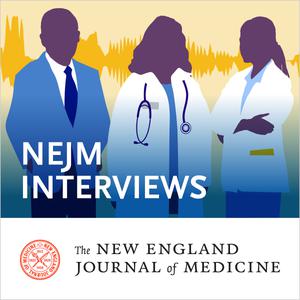
SERious EPI
Sue Bevan - Society for Epidemiologic Research
SERious EPI is a podcast where leading epidemiology researchers are interviewed on cutting edge and novel methods. Interviews focus on why these methods are so important, what problems they solve, and how they are currently being used.
- 55 minutes 33 secondsS4E6: Instrumental Variables with Dr. Rita Hamad
In this episode, we discuss instrumental variables with Dr. Rita Hamad of Harvard’s TH Chan School of Public Health. This episode is focused on the first part of Chapter 28 of Modern Epidemiology 4th edition on quasi experimental methods. We start with what quasi experimental designs are and why we would want to use them (and whether more epidemiologists are being exposed to them). We also talk about why these methods are more common in economics than in epi. We talk about how these methods try to take advantage of something that approximates randomization to estimate causal effects. We talk about what instrumental variables are and the conditions required to be met for a variable to be an instrument. We focus on the strengths and limitations of the methods and when they make the most sense to use them. We talk about what happens when you violate the assumptions of IV. We talk about weak and strong IVs and we talk about Mendelian randomization and its role in epi. And we ask the age-old question, how do you find the elusive instrumental variable?
15 January 2025, 6:00 am - 52 minutes 24 secondsS4E5: Mediation Continuation
In this episode we follow up on our conversation about mediation. We talk about what mediation is and when it is useful. We talk about the history of these methods. We debate what direct and indirect effects are. We describe natural and controlled effects. We discuss the importance of the number 666 in Matt’s life. We talk about exposure mediator interaction. Matt learns what kinesiology is. We discuss proportion mediated and proportion eliminated. And we talk about the confounding assumptions needed for mediation analysis.
15 December 2024, 6:00 am - 58 minutes 35 secondsS4E4: Mediation with Kara Rudolph and Ivan Diaz
In this episode, Matt and Hailey talk with Dr. Kara Rudolph and Dr. Ivan Diaz about mediation analysis. We talk through what it is, what it means and when we want to do it. We talk about mechanism of causation and how mediation can help. We cover things like natural direct and indirect effects and controlled direct effects (and why there isn’t a controlled indirect effect – a thing that stumped Matt for some time). And we discuss the different assumptions need to draw valid inferences in a mediation analysis, like all the many no confounding assumptions and the cross world assumption. And we talk about what Matt refers to as mediated moderation (interaction in the effect on the outcome between the exposure and mediator).
15 November 2024, 6:00 am - 53 minutesS4E3: How do we define efficiency?
In this episode, Hailey and Matt continue on their discussion on study efficiency and realize that we think about efficiency in very different ways. We talk about the difference between statistical efficiency and cost efficiency and we each make our case for one of them being the driving force in how we design and analyze studies. It may be the biggest disagreement we’ve had yet (though maybe that was interaction).We talk about matching and its impact of efficiency and also why we do matching. And we try to understand when matching is useful.
Studies mentioned in the podcast:
- Rothman KJ, Poole C. A strengthening programme for weak associations. Int J Epidemiol. 1988 Dec;17(4):955-9. doi: 10.1093/ije/17.4.955. PMID: 3225112.
15 October 2024, 6:00 am - 51 minutes 56 secondsS4E2: Study Efficiency with Robert Platt
In this episode we are joined by Professor Robert Platt of McGill University to talk about study efficiency and the ways we can think about this in terms of study design. We talk about hierarchies of evidence and its relationship to things like target validity. We get into why we think case control studies are so often misunderstood, particularly with respect to missing that they should be nested within a cohort. We talked about the varying definitions of efficient (variance, efficiency of confounding control, cost efficient, etc.) and how they relate to different study designs, and we disagreed about which definition is the most useful. And we talk about sampling and how it affects study efficiency and also what question we are asking.
The paper that Rob reads over and over is:
- Kurth T, Walker AM, Glynn RJ, Chan KA, Gaziano JM, Berger K, Robins JM. Results of multivariable logistic regression, propensity matching, propensity adjustment, and propensity-based weighting under conditions of nonuniform effect. Am J Epidemiol. 2006;163:262-70.
We also referenced:
- Westreich D, Edwards JK, Lesko CR, Cole SR, Stuart EA. Target Validity and the Hierarchy of Study Designs. Am J Epidemiol. 2019;188:438-443.
- Kramer MS, Guo T, Platt RW, Shapiro S, Collet JP, Chalmers B, Hodnett E, Sevkovskaya Z, Dzikovich I, Vanilovich I; PROBIT Study Group. Breastfeeding and infant growth: biology or bias? Pediatrics. 2002;110(2 Pt 1):343-7.
15 September 2024, 6:00 am - 36 minutes 15 secondsS4E1: We’re Baaaaack… A Season 4 Preview
We kick off season 4 by reminiscing about the origins of the podcast and preview what’s upcoming for season 4 where we will continue on our last season of reviewing Modern Epidemiology 4th edition. We touch on a few of the topics we are most excited about for the coming season and we preview some small formatting changes. But then we put each other through the fun questions that we ask our guests so you all can get to know us better (spoiler: Matt has no idea what the word non-fiction means). We are excited for our upcoming guests this season and the fun conversations we have in store.
3 September 2024, 6:00 am - 41 minutes 11 secondsS3E12: Start with the questions that are easy to answer and then move on to the more challenging questions
It’s hard to believe this is the final episode of season 3! In this season finale episode, we continue our discussion of topics related to Chapter 26 in Modern Epidemiology (4th Edition) with Dr. Eric Tchetgen Tchetgen. In this conversation we ask Dr. Tchetgen Tchetgen to help us better understand several issues related to interaction, including why it’s so important to study interaction. He provides a helpful framework for thinking about interaction: start simple and then move on to more complex questions. As part of this framework, he emphasizes the distinction between total effects and main effects, how confounding plays into conversations about interaction, and the role of scale dependence when interpretating interaction.
30 January 2024, 6:00 am - 47 minutes 17 secondsS3E11: You say tomato, I say tom-ah-to: a (somewhat) head-spinning discussion about interaction analyses
Matt and Hailey take a deep dive into Chapter 26 in Modern Epidemiology, 4th Edition, Analysis of Interaction. This episode needs a content warning- it is among the most advanced and conceptually complex topics we have ever covered on SERious Epi. Interaction occurs when the effect of one exposure on outcome depends in some way on the presence or absence of another exposure. Seems like a simple enough concept, right? However, as you’ll see in this episode, there are many different layers of complexity to consider related to terminology, scale, and interpretation of interaction analyses.
A note from Matt and Hailey: since this material is very complex, we reached out to Dr. Jay Kaufman for his perspective on the episode before releasing it. He had some very helpful thoughts, and we would like to share them with you (paraphrasing with his permission):
Part of what is confusing about this topic is the terminology differences, with Hailey using terminology (“interaction”) that lines up with that used by VanderWeele, ME4, and the Hernán and Robins textbook chapter and Matt using terminology (“interdependence”) from other articles in the literature, such as Greenland and Poole (1988). When there are joint effects that are exactly multiplicative, or supermultiplicative, you know it’s a causal interaction (i.e., synergistic or biologic interaction) because multiplicativity is necessarily super-additive as long as both exposures meet consistency, exchangeability, and positivity assumptions. However, knowing that joint effects are submultiplicative is not informative about additive interaction or synergism. It is also not possible to make a conclusion about additive interaction when a results section tells you only that in a logistic or Cox regression analysis there is “no significant interaction effect (p<0.05)” as that just tells you an effect is not exactly multiplicative. Multiplicativity has some causal implications because it is super additive as long as the causal assumptions listed above are plausibly satisfied. There are several proposed causal mechanisms that would generate multiplicative joint effects especially from the cancer epidemiology literature (e.g., Koopman 1990). In general, considering interaction on the additive scale is more useful for assessing public health relevance (e.g. Panagiotou and Wacholder 2014).
Some of these concepts are difficult to convey in podcast format, so we’re including some helpful resources for anyone interested in learning more about this topic. Thanks again to Dr. Kaufman for helping us put this list together:
- Greenland S, Poole C. Invariants and noninvariants in the concept of interdependent effects. Scand J Work Environ Health. 1988 Apr;14(2):125-9. doi: 10.5271/sjweh.1945. PMID: 3387960.
- VanderWeele TJ. On the distinction between interaction and effect modification. Epidemiology. 2009 Nov;20(6):863-71. doi: 10.1097/EDE.0b013e3181ba333c.
- VanderWeele TJ. The Interaction Continuum. Epidemiology. 2019 Sep;30(5):648-658. doi: 10.1097/EDE.0000000000001054. PMID: 31205287; PMCID: PMC6677614.
- Greenland S, Poole C. Invariants and noninvariants in the concept of interdependent effects. Scand J Work Environ Health. 1988 Apr;14(2):125-9. doi: 10.5271/sjweh.1945. PMID: 3387960.
- Koopman JS, Weed DL. Epigenesis theory: a mathematical model relating causal concepts of pathogenesis in individuals to disease patterns in populations. Am J Epidemiol. 1990 Aug;132(2):366-90. doi: 10.1093/oxfordjournals.aje.a115666. PMID: 2372013.
- Panagiotou OA, Wacholder S. Invited commentary: How big is that interaction (in my community)–and in which direction? Am J Epidemiol. 2014 Dec 15;180(12):1150-8. PMID: 25395027.
15 January 2024, 6:00 am - 48 minutes 5 secondsS3E10: Time-varying everything everywhere all at once
In this episode, we are joined by Dr. Sonia Hernandez Diaz for a discussion on Chapter 25 in Modern Epidemiology, 4th edition. This chapter is focused on methods for causal inference in longitudinal settings, with a particular focus on time varying exposures. Dr. Hernandez-Diaz helps to explain some of the conceptual and methodological challenges related to time-varying exposures, including the advanced analytic strategies required and the careful conceptual considerations about defining the exposure of interest and causal questions.
Papers referenced in this episode:
9 January 2024, 8:05 pm - 40 minutes 22 secondsS3E9: Feedback loops? Feedback spirals? Disentangling what we know about time-varying exposures.
This episode is focused on Chapter 25 of Modern Epidemiology 4th edition, Causal Inference with Time Varying Exposures. In this episode, Matt and Hailey talk about how we should think about exposures that change over time. We discuss the concept of feedback loops- scenarios where the exposure affects outcome which affects a later time point of exposure and then that exposure affects a later outcome. We think about whether biologic (mechanistic) conceptualizations of feedback loop the same as the epidemiologic notion presented in the chapter. We then follow the chapter to continue our discussion about how time varying exposures change our frameworks for thinking about causal inference and analytic strategies (e.g., marginal structural models, g-formula, and structural mean models).
A historical note about Andrew James Rhodes, whose picture is hanging up in the conference room that Hailey was recording from:
https://discoverarchives.library.utoronto.ca/index.php/rhodes-andrew-james31 October 2023, 6:00 am - 42 minutes 57 secondsS3E8: Maybe censoring is the least of your worries?Recording from across the globe, in Melbourne, Australia, Dr. Margarita Moreno-Betancur joins us for an episode on Chapter 22 in Modern Epidemiology (4th edition) on Time-to-Event Analyses. This is a chapter focused on the methods we use when the timing of the occurrence of the event is of central importance. Dr. Moreno-Betancur answers all our questions about these types of analyses, including: the importance of the time scale, defining the origin (time zero), censoring vs. truncation. We also ask Dr. Moreno-Betancur to weigh-in on a hot take about whether the Cox Proportional Hazard model is overused in the health sciences literature.30 September 2023, 6:00 am
- More Episodes? Get the App
Your feedback is valuable to us. Should you encounter any bugs, glitches, lack of functionality or other problems, please email us on [email protected] or join Moon.FM Telegram Group where you can talk directly to the dev team who are happy to answer any queries.
 Hidden Brain
Hidden Brain
 Free Associations
Free Associations
 Public Health On Call
Public Health On Call
 Shiny Epi People
Shiny Epi People
 The Ezra Klein Show
The Ezra Klein Show
 NEJM Interviews
NEJM Interviews